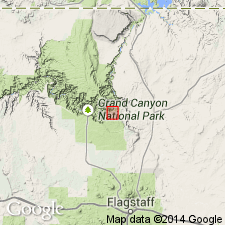
- Usage in publication:
-
- Ochoa Point Member
- Modifications:
-
- Named
- Dominant lithology:
-
- Siltstone
- Sandstone
- AAPG geologic province:
-
- Southern Rocky Mountain region
Summary:
Named as the upper member of Dox Formation (redefined) of Unkar Group [of Grand Canyon Supergroup] for Ochoa Point, west of Basalt Canyon, northwest side of Colorado River, Coconino Co, AZ in the Southern Rocky Mountain region. Type section designated in an unnamed stream, southwest side Ochoa Point. Is 76 km thick at type. Is 53 ft thick at Espejo Creek 4.8 km to northeast, and 91 m thick on Tanner and Cardenas Creeks. Lower half is a slope forming reddish-brown micaceous siltstone that has interbeds of sandstone. Mudcracks and salt crystals present. Upper half has thicker sandstone that has asymmetrical ripple marks and small scale cross beds. Overlies Comanche Point Member (new) of Dox. Underlies Cardenas Lavas of Unkar Group. Is a tidal-flat deposit. Of late Precambrian age. Geologic map.
Source: GNU records (USGS DDS-6; Denver GNULEX).
For more information, please contact Nancy Stamm, Geologic Names Committee Secretary.
Asterisk (*) indicates published by U.S. Geological Survey authors.
"No current usage" (†) implies that a name has been abandoned or has fallen into disuse. Former usage and, if known, replacement name given in parentheses ( ).
Slash (/) indicates name conflicts with nomenclatural guidelines (CSN, 1933; ACSN, 1961, 1970; NACSN, 1983, 2005, 2021). May be explained within brackets ([ ]).

